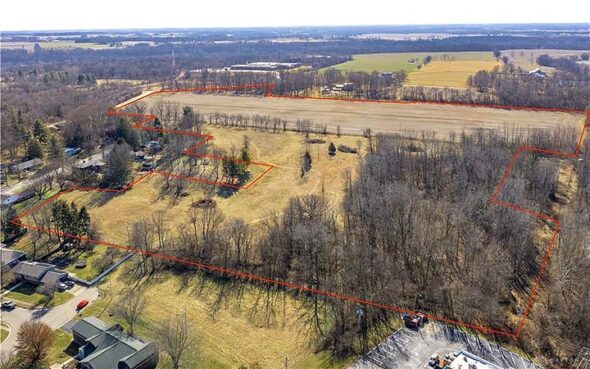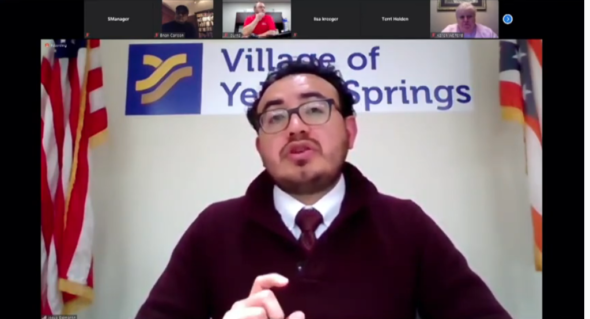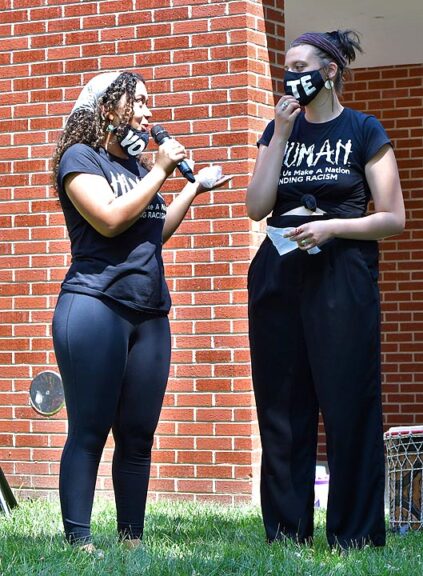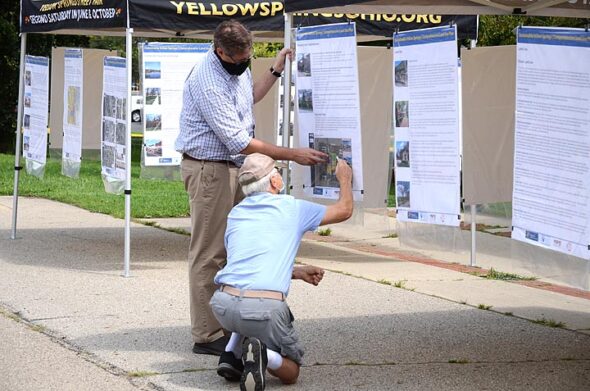
An aerial view of the 51 acres that the Miamisburg developer Oberer purchased for a residential development of an estimated 138 units. About a third of the land (foreground) lies within the Village’s corporation limit, while 34 acres in Miami Township will be part of an annexation petition. (Photo courtesy of ChrisK Realtors)
2020 Year in Review: Village Council
- Published: January 6, 2021
January & February
• “A Welcoming Community” is the new tagline of the Village, Village Manager Josué Salmerón announced in January.
• Kineta Sanford finished her two-year appointed term at the beginning of the year. Newly elected Council member Laura Curliss took her place. The other Council members of 2020 were Brian Housh, president, Marianne MacQueen, vice president, Lisa Kreeger and Kevin Stokes.
• The challenges at the Village’s wastewater treatment plant were discussed at Village meetings in January after EPA rebukes on how the system has handled high-rain events. The Village committed to reducing inflow and infiltration of rainwater entering the sewers, as the local treatment plant had been overwhelmed at times.
• In January, the Village decided to sell some Renewable Energy Credits, which it receives for purchasing green energy. About 83% of the local electric portfolio is renewable. In the end, the Village decided to sell half of their credits and repurchase the other half at a lower cost — for a net of $183,000. The money would not be returned to rate-payers, but used to fund infrastructure projects, Council decided.
• In January, an open house was held for the Village comprehensive land use plan, which had been in development since September 2019. Aaron Sorrell of Community Planning Insights of Dayton led the effort, which cost $30,000. It was the last full public meeting on the plan, which took several months longer than expected due to the pandemic.
• The Village began considering a villagewide rooster ban in January after noise complaints related to crowing roosters at a Northwood Drive residence. Planning Commission recommended the move, but soon after, the roosters moved out of town and Council tabled the matter.
• In January, Council officially designated the Yellow Springs Development Corporation, or YSDC, as its community improvement corporation.
• Glen Cottages, Home, Inc.’s pocket neighborhood at 1133 Xenia Ave., got the go-ahead from Planning Commission in February. The new neighborhood will be located on just over an acre of land on the east side of Xenia Avenue north of Woodrow Street and will feature six single-family cottages and three rental garden cottage duplexes, for a total of 12 units. Construction began later in the year.
• Council struck a provision, passed the previous year, that had banned clapping, snapping and signs at Council meetings.

Village Manager Josué Salmerón shared efforts to safeguard employees while continuing services during a “virtual town hall” broadcast and streamed online on March 16. (Screen capture)
March & April
• Council meetings were temporarily halted in March following the statewide stay-at-home orders to slow the spread of the coronavirus pandemic. Instead, the Village hosted daily, then tri-weekly, and then weekly, “virtual town halls,” updating the community on the pandemic’s spread and the local response. Among the Village responses to the pandemic, no utility shut-offs would take place, Village staff began new rotating shifts and Village staff coordinated with other local groups to meet food and other needs.
• Three people were personally present in Council chambers on Monday, April 6, for Yellow Springs Village Council’s first full meeting since in-person gatherings were limited during the pandemic. Virtual Council meetings, which were permitted by the state during the emergency, continued for the rest of the year.
• Council declared a state of emergency in the Village on April 20. It followed earlier declarations by the state on March 9 and county on March 14.
• In April, Council gave $35,000 to the YSDC. The money came from the Village’s economic revolving loan fund, but had not been used for more than a decade. Those funds were later used for refundable loans to local businesses for COVID-19 relief.
May & June
• The Village announced the Gaunt Park pool would reopen in June, with changes to improve safety in light of COVID-19, such as “locals-only” days. Some criticized the move, and an online petition asked the Village to keep the pool closed over the summer.
• Council passed a resolution encouraging people to wear masks downtown after criticism that the Village and Chamber’s “Be Kind” messaging was too soft. Some still thought the resolution, which did not carry the force of law, didn’t go far enough.
• In June, Council passed an ordinance approving the right of village renters to “pay to stay.” The legislation would compel local landlords to accept late payments so that a tenant can stay, rather than be evicted, and would be enforced at Greene County Municipal Court.
• Council moved forward in June to reduce its 2020 spending budget by $512,946, which is an estimated 12% decline. Then-Village Finance Director Colleen Harris reported that the cuts were necessary after the Village determined it may lose more than $328,000 in revenue due to the COVID-19 pandemic. About half of the cuts came from the line item for street maintenance and repair.
• In June, Council agreed to not extend for another year a preliminary PUD plan for the Millworks business park on Walnut Street. Millworks’ owner, Jessica Yamamoto, had applied in March for a 12-month extension of the plan, which called for studio apartments, a hostel and other changes at the site. As of December, Millworks was listed for sale.
• Council declared racism a public health crisis in June and committed to reforming local policing, improving affordability for residents and prioritizing racial equity in decision-making, among other steps.

Organizers Nya Brevik, left, and Julia Hoff conferred at a Black Lives Matter rally. The two also pressed Village Council to take swifter action to address racism in the village. (Photo by Kathleen Galarza)
July & August
• In July, Council stepped up its efforts to enforce mask-wearing downtown by passing an ordinance requiring masks, with fines for those who don’t comply. Although local police initially opted for verbal warnings, they had begun issuing citations by year’s end.
• Breanne Parcels, an attorney with the Springfield firm Gorman, Veskauf, Henson & Wineberg, was sworn in as the new Village solicitor in July. Parcels replaced Chris Conard, who had served as Village solicitor since 2015.
• In July, Richard Lapedes and consultant Beth Miller of Wagstown, shared with Council a proposal for a local dog park to be built on a 1.25-acre parcel near the water towers at Gaunt Park. The site would be outfitted with fences designating separate areas for large and small dogs, two drinking stations, “dog-friendly benches,” signage and more and estimated to cost $55,600 for its first year.
• Yellow Springs’ charter change allowing noncitizens to vote on local matters came under fire in July from Ohio Secretary of State Frank LaRose, who said the Village’s efforts “undermine the constitution.” LaRose also instructed the county board of elections office to not accept noncitizen registrations. Local voters passed the charter amendment in the spring. Although the Village discussed a legal response to defend the provision, no action was taken.
• The Village announced in August that it had received $1.6 million from the Ohio Department of Transportation to fund local transportation initiatives. Projects include: a re-design of the Xenia Avenue/Corry Street intersection; reconstructing a multi-use path along Dayton Street; curb extensions, crosswalk markings and signage at five intersections along Dayton Street and Xenia Avenue and more. Construction is set to begin in 2023.
• An investigation by the Greene County Sheriff’s Office in August cleared YSPD Chief Brian Carlson of wrongdoing. Zo Van Eaton-Meister, the wife of YSPD officer Dave Meister, had filed a formal complaint against Carlson, claiming he verbally accosted her downtown in May.
• In July, a group of local antiracism organizers, mostly young Black women, demanded that Council take more serious action to address racism in the village, presenting a list of demands and a deadline of 48 hours.
• Tensions continued to rise through August between Village officials and local antiracism organizers. Organizers were frustrated that the Village wasn’t responding to their demands, while Village officials aired concerns that organizers were marching weekly without a permit or approved routes and had not acknowledged prior Village efforts to address racism. Another issue for organizers was what they perceived as an overly conciliatory tone used by YSPD Chief Carlson in attempting to persuade a purported KKK member not to counterprotest a planned Black Lives Matter-themed Fourth of July parade. Two Council members later apologized for their communications to organizers.

In August, consultant Aaron Sorrell, left, hosted an eight-hour outdoor open house for villagers to give feedback on the Comprehensive Land Use Plan. Here he spoke with Rick Donahoe. (Photo by Megan Bachman)
September & October
In September, Council launched a new Justice System Collaborative Committee to develop antiracist policies and criminal justice reforms. The informal committee is moving to become an official commission, Council announced at the end of the year.
• Council decriminalized marijuana possession in Yellow Springs in September. The ordinance reduced the offense level and penalties for those caught locally possessing or cultivating less than 200 grams of marijuana, which is about seven ounces. Instead of misdemeanors, those caught will be charged with a civil infraction and fined $50 or less.
• Housing developer Oberer asked Council in September to consider an annexation agreement to add close to 34 acres of land on the Village’s southern border for a residential development with an estimated 138 housing units. Oberer said they were going to seek annexation on part of a 51-acre property located north of East Hyde Road they were under contract to purchase; another portion of the property is already in the village. Oberer estimated homes would start at $300,000 and include duplexes and single-family homes. By the year’s end, the developer had closed on the property but had yet to petition the county for annexation.
• In September, the Council changed the YS Police Department’s part-time social worker position to a full-time position. Known by the title of community outreach specialist, the position is currently filled by village resident Florence Randolph.
• Salmerón announced in September that Village Finance Director Colleen Harris would be leaving her position with the Village for another job. In October, Matt Dillon, a senior management analyst in Cincinnati’s manager’s office, was hired.
• Local apartment complex and commercial property owners must offer recycling services to their tenants, Council decided in September.
• In October, Council approved a new comprehensive land use plan for the Village, a 15-year plan setting out local development priorities. Among the late changes to the plan pushed by Council member Curliss, a design for expanding parking around Mills Lawn was removed and anticipated zoning on the Glass Farm was changed from high-density residential to a combination of medium-density residential and “conservation development.” Two other efforts led by Curliss, to permit no housing on the Glass Farm and to designate the western portion of Mills Lawn as “conservation” if the school ever closed there, failed to pass. In public hearings, several Mills Lawn neighbors argued against the parking concept and for designating the elementary school property for conservation.
• In October, Council voted to make an offer to purchase a three-acre parcel on the southern edge of the Yellow Springs High School property from the school district for a bike path to Agraria. The nonprofit would pay half of the price back over 15 years.
November & December
• A study of the Village’s electric system by an outside consultant concluded that the Village is reaching the limits of its current system, recommending the Village make $4.3 million in upgrades to accommodate possible new development even though local electricity growth is currently slow, at 1.2% per year.
• In November, Planning Commission amended the Village zoning code to eliminate minimum parking requirements in the downtown Central Business District.
• YSPD Officer Dave Meister was cleared in November of wrongdoing after an outside investigation into comments made about another officer. Meister was investigated for possibly violating Village policy and state law by allegedly telling a citizen that a fellow officer referred to some attendees of the weekly Black Lives Matter rallies as an “angry mob.”
• Council Vice President Marianne MacQueen shared the news that the Village of Yellow Springs has been certified by the National Wildlife Federation as a Community Wildlife Habitat.
• In December, free public WiFi went live in downtown Yellow Springs. The Village initiative used coronavirus relief funds to lay down high-speed fiber optic cables in the downtown area, the first phase of a larger project to develop a new broadband internet utility for the Village.
• Council passed a deficit budget for 2021 in which the Village will spend about a million dollars more than it takes in. Village officials said the funds, to be spent on needed infrastructure projects, would come from reserve funds that had accumulated in recent years. Next year, general fund spending — which covers streets, parks, police and most administrative costs — is budgeted at $4.23 million, while revenue is projected at $3.27 million. That will drop the reserve funds to $1.28 million, their lowest level in recent years.
—Megan Bachman
The Yellow Springs News encourages respectful discussion of this article.
You must login to post a comment.
Don't have a login? Register for a free YSNews.com account.















No comments yet for this article.